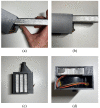Conversion of self-contained breathing apparatus mask to open source powered air-purifying particulate respirator for fire fighter COVID-19 response
- PMID: 32835140
- PMCID: PMC7384434
- DOI: 10.1016/j.ohx.2020.e00129
Conversion of self-contained breathing apparatus mask to open source powered air-purifying particulate respirator for fire fighter COVID-19 response
Erratum in
-
Erratum regarding previously published articles.HardwareX. 2021 Sep 22;10:e00235. doi: 10.1016/j.ohx.2021.e00235. eCollection 2021 Oct. HardwareX. 2021. PMID: 35607661 Free PMC article.
Abstract
To assist firefighters and other first responders to use their existing equipment for respiration during the COVID-19 pandemic without using single-use, low-supply, masks, this study outlines an open source kit to convert a 3M-manufactured Scott Safety self-contained breathing apparatus (SCBA) into a powered air-purifying particulate respirator (PAPR). The open source PAPR can be fabricated with a low-cost 3-D printer and widely available components for less than $150, replacing commercial conversion kits saving 85% or full-fledged proprietary PAPRs saving over 90%. The parametric designs allow for adaptation to other core components and can be custom fit specifically to fire-fighter equipment, including their suspenders. The open source PAPR has controllable air flow and its design enables breathing even if the fan is disconnected or if the battery dies. The open source PAPR was tested for air flow as a function of battery life and was found to meet NIOSH air flow requirements for 4 h, which is 300% over expected regular use.
Keywords: 3-D printing; Additive manufacturing; COVID-19; Medical hardware; Open hardware; PAPR; Personal protective equipment; Powered Air-Purifying Respirator; RepRap; Safety equipment.
© 2020 The Authors.
Conflict of interest statement
The authors declare that they have no known competing financial interests or personal relationships that could have appeared to influence the work reported in this paper.
Figures






































References
-
- World Health Organization, Critical preparedness, readiness and response actions for COVID-19: interim guidance, 7 March 2020 (No. WHO/COVID-19/Community_Actions/2020.1). World Health Organization, 2020.
-
- L. Ramsey, Hospitals could be overwhelmed with patients and run out of beds and ventilators as the coronavirus pushes the US healthcare system to its limits. Mar 11, 2020, 8:53 AM Business Insider. https://www.businessinsider.com/coronavirus-intensive-care-unit-shortage....
LinkOut - more resources
Full Text Sources
Other Literature Sources

